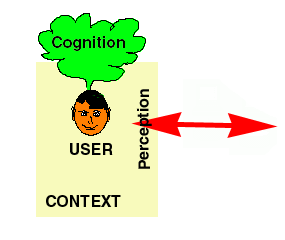
The computer contains a more or less explicitely described user model.
Merriam Webster:
- Cognition = the act or process of knowing including both awareness and judgement;
from co- + gnoscere to come to know
From (Montgomery 1995)
- Processing (Active/Reflective)
Active learners learn best by doing something physical with the information, while reflective learners do the processing in their heads.
- Perception (Sensing/Intuitive)
Sensors prefer data and facts, intuitors prefer theories and interpretations of factual information.
- Input (Visual/Verbal)
Visual learners prefer charts, diagrams and pictures, while verbal learners prefer the spoken word
- Understanding (Sequential/Gloabal)
Sequential learners make linear connections between individual steps easily. While global learners must get the "big picture" before the individual pieces fall into place.
- 67%of the students learn best actively, yet lectures are typically passive;
- 57%of the students are sensors, yet we teach them intuitively;
- 69%of the students are visual, yet lectures are primarily verbal;
- 28%of the students are global, yet we seldom focus on the ``big picture.''
From (funderstanding), link below
- "Concrete and abstract perceivers--Concrete perceivers absorb information through direct experience, by doing, acting, sensing, and feeling. Abstract perceivers, however, take in information through analysis, observation, and thinking.
- Active and reflective processors--Active processors
make sense of an experience by immediately using the new
information. Reflective processors make sense of an experience
by reflecting on and thinking about it.
Traditional schooling tends to favor abstract perceiving and reflective processing. Other kinds of learning aren't rewarded and reflected in curriculum, instruction, and assessment nearly as much. "
Gardners multiple intelligences (see funderstanding below)
- Verbal-Linguistic--The ability to use words and language
- Logical-Mathematical--The capacity for inductive and deductive thinking and reasoning, as well as the use of numbers and the recognition of abstract patterns
- Visual-Spatial--The ability to visualize objects and spatial dimensions, and create internal images and pictures
- Body-Kinesthetic--The wisdom of the body and the ability to control physical motion
- Musical-Rhythmic--The ability to recognize tonal patterns and sounds, as well as a sensitivity to rhythms and beats
- Interpersonal--The capacity for person-to-person communications and relationships
- Intrapersonal--The spiritual, inner states of being, elf-reflection, and awareness
Further reading
- Montgomery S. M., 1995, "Addressing Diverse Learning Styles Through the Use of Multimedia". University of Michigan.
http://fairway.ecn.purdue.edu/v1/asee/fie95/3a2/3a22/3a22.htm.
From the "1995 ASEE/IEEE Frontiers in Education 95 Conference"
http://fairway.ecn.purdue.edu/asee/fie95/Index.htm.
- Funderstanding. About Learning/theories. How do People learn?
http://www.funderstanding.com/theories1.html
Gardners Multiple Intelligences.http://www.funderstanding.com/learning_theory_how6.html
- Problem Based Learning. Sothern Illinois University. School of Medicin. http://edaff.siumed.edu/dept/index.htm